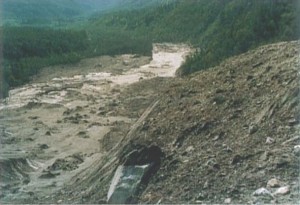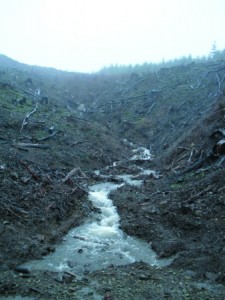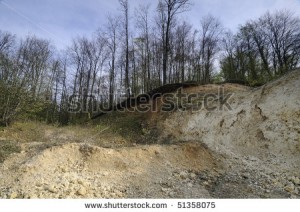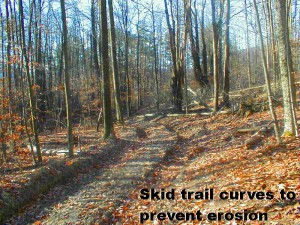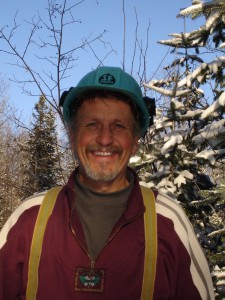By Harry Voelkel
Not all logging is harmful, but if the job is done poorly and without consideration to the site, it can devastate an ecosystem. The removal of dead standing trees and downed wood has severe impacts on animal habitat. Heavy machinery can damage living trees’ stems and fine roots, as well as compacting the soil. Large percentages of the forest, sometimes up to 30% can end up as roads.
http://1.bp.blogspot.com/-2CktSQ4AV1c/UQX1Y9gvcwI/AAAAAAAAA2U/aY3S_G5HbRI/s1600/DSC03949.JPG
The greatest impact logging can have is on the watershed. Poor management of forests can result in the pollution of streams with leaky oil, as well as muddying waters with topsoil runoff and bank erosion. Removal of trees above the streams will lead to the water warming up with too much sunlight, making the brook uninhabitable for cold-water fish, such as trout and salmon, which are prized as game fish along with their ecological role.
http://treesfoundation.org/affiliates/30/images/1239741175_2009_Spring_KSWild_back_WOPR_bad_logging.jpg
Some states have very little regulation at all when it comes to forest management. Vermont, on the other hand, is quite progressive when it comes to harvesting regulations. Some examples of these include the heavy cutting law, which prevents landowners from clearcutting over 40 acres without filing from permission, permission has to be granted to change the course of a stream, deer winterering yards need to be maintained, there is a maximum grade allowed for roads or trails, and permission has to be granted to log above 2,500 feet in elevation. Additionally, all harvests must be in line with scientific forestry methods and silivicultural techniques.
The most important regulations govern the quality of the forest’s watershed. While the landowner may own the soil and the trees, he does not own the water that runs through them. It is the landowners responsibility to ensure that a commonly held resource, such as water, is not reduced in quality.
These rules are called Acceptable Management Practices or AMPs. If these rules are followed, than the landowner and logger are not legally accountable for any soil discharge in streams. Generally, the landowner usually creates a contract with the logger, which holds the logger accountable for the job that he does. If the guidelines have not been followed, and an incident occurs, then they can be brought to court. The penalty for polluting streams is $10,000 for every a day the situation is not rectified
http://www2.dnr.cornell.edu/ext/bmp/images/dh_curvskid-big.JPG
As well as protecting watersheds, these regulations have an added bonus. While they don’t specifically mention silvicultural practices, in order to maintain water quality, good cutting practices have to be utilized. Most of the regulations deal with the acceptable ways to build roads and trails, as well as cross streams. Roads cannot be more than a 10% gradient, and require adequate drainage and erosion controls. Any disturbed soil within 25 feet of a stream must be planted with a cover crop.
Those these regulations are very important for maintaining soil quality, they are still only “acceptable” management practices, not the “best” management practices. While these rules minimize damage from bad practices, landowners still have to be personally motivated to manage their forests ethically. Vermont Family Forests is one organization that is committed to ecological forestry in Vermont. to this end, they have created a checklist with more stringent standards than the state enforced practices. While these are voluntary decisions, they represent the “best” practices for managing Vermont forest communities.
While the practices for trail building are no different from the state’s, these guidelines take into account silvicultural techniques and forest composition. For example, the only regeneration techniques allowed are single-tree and small group selection for hardwood forests and irregular shelterwood for spruce-fir forests. This means that in a hardwood stand, only small gaps of less than two acres in size can be created. A shelterwood treatment means taking off only the overstory of the stand, to release the suppressed trees. By contrast, any form of silvicultural technique is allowed by the state, such as clear-cutting. Furthermore, at least six standing dead trees per acre, and 2 large fallen logs are to be maintained. Timber should be grown on long rotations and to maturity, not market size. Sensitive areas and important animal habitats are to be minimally disturbed, and old growth stands are to be left alone.
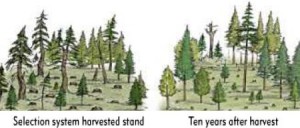 http://www.forestrynepal.org/images/selection-system.jpg
http://www.forestrynepal.org/images/selection-system.jpg
I believe that this is the kind of forestry that needs to be practiced across the northeast. I think resource extraction is fine, but we need to manage our forests to replicate natural systems. Methods like single-tree selection and group selection replicate the natural disturbance regimes of the northeast, individual tree mortality and windstorms. Forests thrive when they are diverse. These small openings add to the diversity, allowing regeneration and creating a patchwork of habitat and conditions suitable for many plant and animal species. Maintaining every cog and wheel will allow our forests to run smoothly and provide us with quality timber for centuries to come.
http://1.bp.blogspot.com/-2CktSQ4AV1c/UQX1Y9gvcwI/AAAAAAAAA2U/aY3S_G5HbRI/s1600/DSC03949.JPG
links:
http://www.familyforests.org/ecoforestry/documents/ForestMgmtChecklist.pdf
http://www.vtfpr.org/resource/documents/UVA/Forest%20Management%20Standards.pdf
http://www.vtfpr.org/watershed/documents/Amp2009pdf.pdf
http://www.vtfpr.org/regulate/documents/Timber_Harvest09_web.pdf

